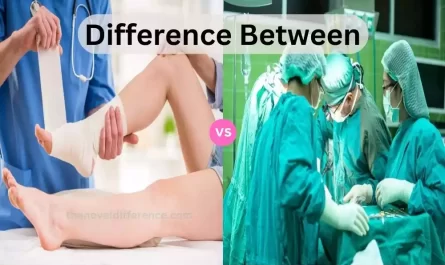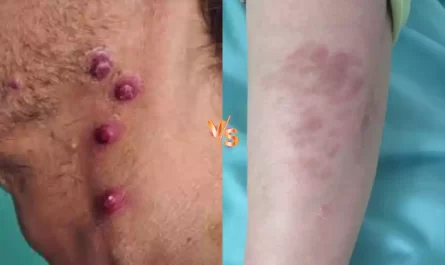The skin, which is our body’s largest organ, may display a myriad of ailments and two of them are Vitiligo as well as Psoriasis. While both can affect the face, these conditions differ greatly regarding their causes, signs, and treatment. Knowing the differences is essential to ensure a correct diagnosis and efficient treatment.
This short overview seeks to clarify the distinctions between Vitiligo and Psoriasis by shedding an understanding of their distinctive features, their impact on people, and treatment strategies that differ.
What is Vitiligo?
Vitiligo is a chronic skin disorder that is characterized by the absence of pigmentation in the skin resulting in depigmented, irregular patches on various areas of the body. The disorder is caused by melanocytes, which are the cells responsible for the production of pigment (melanin) on the skin, dying or ceasing to function.

Certain parts of the skin begin to lose color, causing the appearance of spots or white patches. Vitiligo can affect anyone regardless of age, race, or gender, and although it isn’t contagious and life-threatening in nature, it may have a significant psychological and emotional impact on people due to its apparent characteristics.
The reason for vitiligo’s occurrence isn’t completely understood, however, it is believed that it involves an interaction of autoimmune, genetic, and environmental triggers.
What is Psoriasis?
Psoriasis is a chronic, autoimmune skin condition that is characterized by the rapid development of skin cells which results in the development of red, thick, flaky patches on the skin’s surface.
These patches, referred to as plaques, typically appear on knees, and elbows as well as on the scalp and low back. They can affect other parts of the body. Psoriasis is caused by an immune system that is overactive which mistakenly attacks healthy skin cells and triggers an excessive turnover of cells.
This rapid cell growth cycle leads to the growth in skin cell count on the surface of the skin, creating distinctive plaques. Itching can be a result of the condition as well as discomfort and, in certain cases pain.

Psoriasis is characterized by its long-term nature, with flare-ups as well as remissions of varying intensity and duration among those affected. While it isn’t contagious the condition has a profound impact on the well-being and could be connected to other conditions, such as psoriatic arthritis.
The precise causes of psoriasis aren’t yet fully understood, but it is believed to be caused by the interaction of the genetic or immune system, as well as environmental elements.
Importance of understanding the differences between Vitiligo and Psoriasis
Understanding the difference between Vitiligo as well as Psoriasis is crucial for many reasons:
- Accurate diagnosis Achieving Accurate Diagnosis: Each of Vitiligo and Psoriasis have distinct symptoms and features. Knowing the distinctions aids healthcare professionals in accurately diagnosing the condition, avoiding mistaken diagnoses, and providing appropriate treatment.
- Individualized Treatment: Effective treatment of these diseases requires specialized treatment strategies. Understanding their distinct characteristics aids in the selection of appropriate treatments that include topical treatments phototherapy, systemic drugs, or more recent biologic drugs, maximizing the patient’s outcomes.
- Psychological Effects: Vitiligo and Psoriasis can profoundly affect a person’s mental well-being due to their visibility and possible stigmatization by society. Understanding the distinctions can provide targeted support and coping strategies that address the unique emotional challenges that come with each.
- Educational and Awareness: Having a better understanding of these ailments fosters compassion, dispels myths, and creates a welcoming and accepting society. A greater awareness of the condition can help to eliminate myths and stereotypes regarding skin disorders while reducing social stigma, and helping those who suffer.
- Research and Development: Understanding the differences between Vitiligo and Psoriasis is the main focus of ongoing research. This encourages exploration of different triggers, mechanisms, and treatment targets possibly leading to new treatments and improved strategies for managing the condition.
- Self-determination of Patients: Patients empowered with information about their illness can be involved in their treatment strategies, making informed choices and implementing self-care strategies that are appropriate for them.
Understanding the differentiators in Vitiligo as well as Psoriasis is essential for accurate diagnosis, individualized treatment, psychotherapy, social awareness as well and helping those affected to manage their condition and overall well-being.
Comparison Table of Vitiligo and Psoriasis
Here’s a comparison table outlining the key differences between Vitiligo and Psoriasis:
| Aspect | Vitiligo | Psoriasis |
|---|---|---|
| Definition | Skin condition causing depigmented patches due to melanocyte loss | Chronic autoimmune disorder causing red, scaly patches (plaques) due to rapid skin cell growth |
| Cause | Melanocyte destruction or dysfunction; autoimmune, genetic, and environmental factors | Overactive immune system targeting healthy skin cells; genetic, immune, and environmental factors |
| Symptom Appearance | Irregular, white patches or spots on various body areas | Red, thickened, scaly patches (plaques) on elbows, knees, scalp, and other body regions |
| Skin Changes | Loss of skin pigment (depigmentation) | Excessive skin cell growth (hyperproliferation) resulting in plaques |
| Locations Affected | Any area of the body, including the face, hands, elbows, knees | Predominantly on elbows, knees, scalp, lower back, but can affect various body parts |
| Itching | Generally not associated with itching | Often accompanied by itching and discomfort |
| Triggers | Sun exposure, stress, autoimmune factors | Stress, skin injuries, infections, medications |
| Associated Conditions | Autoimmune disorders may coexist | Psoriatic arthritis, cardiovascular diseases, metabolic syndrome |
| Diagnosis | Clinical examination, Wood’s lamp, skin biopsy | Clinical examination, skin biopsy, medical history |
| Treatment | Topical corticosteroids, phototherapy, skin grafting | Topical treatments, systemic medications, biologics, light therapy |
| Psychological Impact | Social stigma due to visible patches | Visible plaques may cause emotional distress |
| Contagious | Not contagious | Not contagious |
This table provides a summarized overview of the differences between Vitiligo and Psoriasis, encompassing aspects such as cause, symptoms, affected areas, diagnosis, treatment, and their respective impacts on individuals.
Similarities between Vitiligo and Psoriasis
Although Vitiligo as well as Psoriasis have distinct skin disorders, both do share certain similarities:
- Autoimmune Component: Both of the conditions are caused by an autoimmune response in which the immune system attacks the body’s own cells. In Vitiligo melanocytes (pigment-producing cells) are targeted and lead to depigmentation. In Psoriasis the immune system targets healthy skin cells and causes rapid growth of skin cells.
- Impact on quality of life: The two conditions Vitiligo and Psoriasis could have a major impact on a person’s psychological well-being and overall quality of life because of their obvious characteristics. Skin appearance changes in both conditions could result in feelings of self-consciousness, shame, and psychological stress.
- Chronic Nature: Vitiligo as well as Psoriasis is a chronic condition that is characterized by a series of flare-ups, and periods of remission. The severity or frequency could differ however both conditions tend to last for long durations.
- Genetic Factors: Vitiligo and Psoriasis are genetically predisposed. Patients who have a family background of either disease are more likely to be affected by these conditions.
- Triggers: Specific triggers could trigger flare-ups or worsen symptoms for both diseases. Skin injuries, stress, or infections, as well as exposure to factors in the environment such as sunlight exposure could cause or worsen symptoms in each of Vitiligo or Psoriasis.
- Effect upon Associated Health Conditions: Both Vitiligo and Psoriasis are linked to the risk of having other health issues. For instance, Psoriasis is linked with psoriatic arthritis. Vitiligo can be co-existent with other autoimmune diseases.
Although these similarities are present, it is important to understand it is the case that Vitiligo as well as Psoriasis are distinct diseases with distinctive characteristics in terms of appearance, symptoms affected areas, symptoms, and treatment strategies.
Understanding these similarities can assist in recognizing the common features that are shared by both diseases, but a precise diagnosis and customized treatments that are specific to each condition are essential to a successful treatment.
Conclusion
While Vitiligo and Psoriasis have some commonalities they’re distinct skin conditions that have their own characteristics their causes, as well as methods of treatment.
Knowing the distinctions between these two conditions is crucial to ensure a precise diagnosis, individualized treatment strategies, and proper support for those who suffer from chronic skin diseases.
Awareness, understanding, and continuous research are essential to improve the treatment and quality of life for people living with Vitiligo or Psoriasis.




